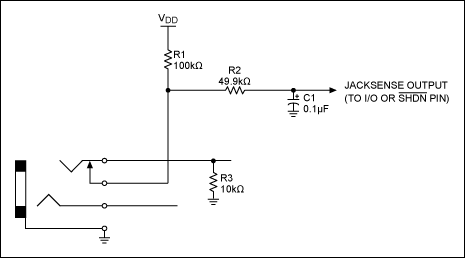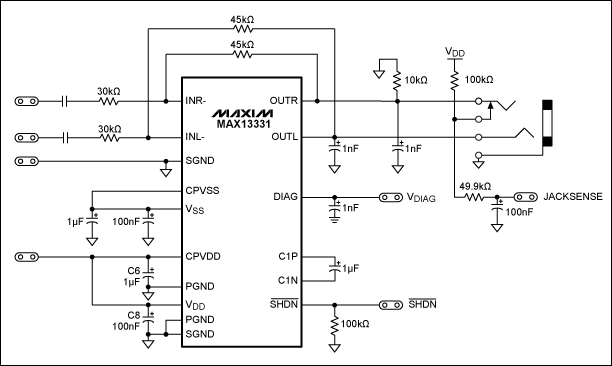

Add a Discrete Jack-Sensing Ci
嵌入式设计应用
134人已加入
描述
Add a Discrete Jack-Sensing Circuit to the MAX13330/MAX13331 Automotive Headphone Amplifier
Abstract: This application note describes how to add a discrete jack-sensing (JACKSENSE) circuit to the MAX13330/MAX13331 DirectDrive® headphone amplifier.
|
Introduction
The MAX13330/MAX13331 automotive headphone amplifier meets the requirements of most automotive applications, but there are instances where other features are needed. Sensing when a headphone is inserted into the audio jack is sometimes an application requirement. This capability can easily be added to any DirectDrive headphone amplifier, as long as there is a microcontroller available to decode the additional signals generated.Jack-Sensing Circuit
Adding a discrete jack-sensing circuit to a device typically requires just a few low-cost passive components. The exact values of each component depend on the system requirements, but the basic circuit should remain the same. Typically a four-contact audio jack is used where the extra contact is a normally-closed switch connected to the left or right audio contact. When a plug is inserted the switch opens. The circuit in Figure 1 shows the basic jack-sensing circuit. Figure 2 shows a schematic diagram of the MAX13330/MAX13331 with the jack-sensing circuit.The jack-sensing circuit can be used to automatically enable the MAX13330/MAX13331 when a plug is inserted into the jack. Connect the output of the jack-sensing circuit directly to the active-low SHDN pin to implement this function.

Figure 1. Jack-sensing circuit.

Figure 2. Schematic diagram of MAX13331 with discrete jack-sensing circuit.
Filter Selection
The RC filter consists of R2 and C1, and allows the jack-sensing detection times to be adjusted and the audio signals to be filtered. R2 and C1 can be selected to meet the requirements of each application. Table 1 gives a typical range of C1 capacitor values along with associated jack detection times and RC filter parameters.If audio will be present when no plug is inserted into the jack and if the rising threshold of the digital input is < 2.2V, then select a capacitor value that will filter out the audio signal. The MAX13330/MAX13331 has a maximum audio signal of ~2.2V. Therefore, a capacitor value of 0.47µF is adequate to keep the jack-sensing output below 0.6V, which will be a "0" for most digital inputs. To minimize the jack detection times, adjust the capacitor value based on the specific digital input threshold.
A Schmitt-trigger inverter or buffer can be added to eliminate the need to filter the audio signal, as the rising-edge threshold will be above the maximum audio signal. With the small cost of the inverter/buffer, this modification provides the added flexibility of adjusting the jack detection times.
Table 1. Typical C1 Filter Values
| C1 (µF) | Jack-Present Detection Time (ms)* | Plug-Removal Detection Time (ms)** | Cutoff Freq. (Hz) | -12dB (Hz) |
| 0.01 | 1 | 0.4 | 320 | 1234 |
| 0.047 | 5 | 1.6 | 68 | 264 |
| 0.1 | 10 | 3.5 | 32 | 123 |
| 0.22 | 23 | 8 | 15 | 44 |
| 0.47 | 49 | 16 | 7 | 27 |
| 1.0 | 104 | 35 | 3 | 12 |
**MAX13330/MAX13331 enabled (EN high) with no audio present.
声明:本文内容及配图由入驻作者撰写或者入驻合作网站授权转载。文章观点仅代表作者本人,不代表电子发烧友网立场。文章及其配图仅供工程师学习之用,如有内容侵权或者其他违规问题,请联系本站处理。
举报投诉
- 相关推荐
- 热点推荐
- Amplifier
-
Discrete SVPWM Generator模块2013-04-29 11243
-
如何计算输出时钟的DISCRETE JITTER?2019-03-22 2095
-
Ci522 /Ci523的特性是什么2021-12-29 982
-
QN908x Capacitive Sensing设计资料分享2022-12-14 511
-
ADD8504/ADD8505/ADD8506,pdf da2009-09-02 1123
-
Current Sensing Solutions for2009-12-04 542
-
Ratiometric Sensing Using the2010-05-20 522
-
什么是ADM (Add/Drop Multiplexer)2010-02-22 3279
-
感谢你!Jack Kilby2020-09-17 1690
-
ADD8754-EVAL:LCD电源、VCOM和栅极调制评估套件(版本A,3/07)2021-04-23 519
-
Ci522/CI523芯片替代RC522手机NFC开锁方案2022-10-12 2027
-
Pumpkin Jack南瓜灯开源2023-02-02 678
-
【新品推送-Ci520/Ci521】 兼容Si522/Si523的超高性价比解决方案2022-08-31 2467
-
更多选择!Ci522/Ci523的新封装QFN20/3*3*0.8mm2023-04-21 4132
全部0条评论

快来发表一下你的评论吧 !

